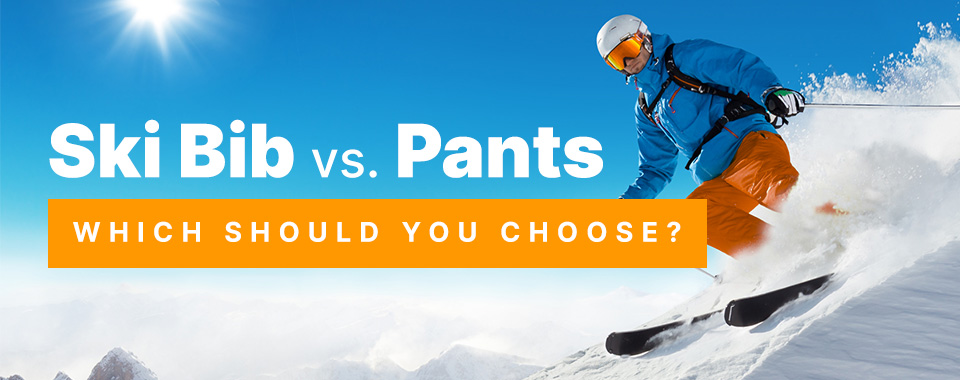 Ski Bib vs. Pants: Which Should You Choose?
Ski Bib vs. Pants: Which Should You Choose?
Ski Bib vs. Pants: Which Should You Choose?
Posted
by
Buckman's Ski & Snowboard Shops
on Monday, March 18, 2024
Ski bibs and pants are crucial components of ski and snowboard gear and help you stay protected, comfortable and warm in the snow. However, choosing between the two can seem like a daunting task. Ask any longtime skier about bibs or pants for skiing, and you'll get polarizing opinions on which is best. Both will help tremendously on the slopes, and you should base your choice on your own personal preferences and needs.
In this guide, you'll learn the difference between ski bibs and pants and their advantages and disadvantages. You'll also learn how your skiing style can influence your decision and which factors you should consider to help narrow your options. By the end of the article, you should know what to buy for your next adventure.
- Difference Between Ski Bibs vs. Ski Pants
- Which Is Better: Ski Pants or Bibs?
- Making the Right Choice for Your Skiing Style
- Considerations When Shopping for Ski Pants or Bibs
The Difference Between Ski Bibs vs. Ski Pants
Ski bibs and pants are similar types of ski clothing. They both cover your legs, protecting them from snow and keeping them warm. There are several key differences between the two, which will impact your ski experience in various ways. Learn more about both options below to see which one you may prefer.
What Are Ski Bibs?
Ski bibs — also known as ski overalls or salopettes — are like regular overalls but for skiing. They're a one-piece suit with pants and an attached front panel that covers the torso. Adjustable straps or built-in suspenders go over the shoulder to secure the ski bib to your body so they don't fall down. Ski bibs offer multiple benefits and a unique style that some skiers prefer while backcountry skiing, but you'll even see people wearing them on manicured slopes in ski resorts.
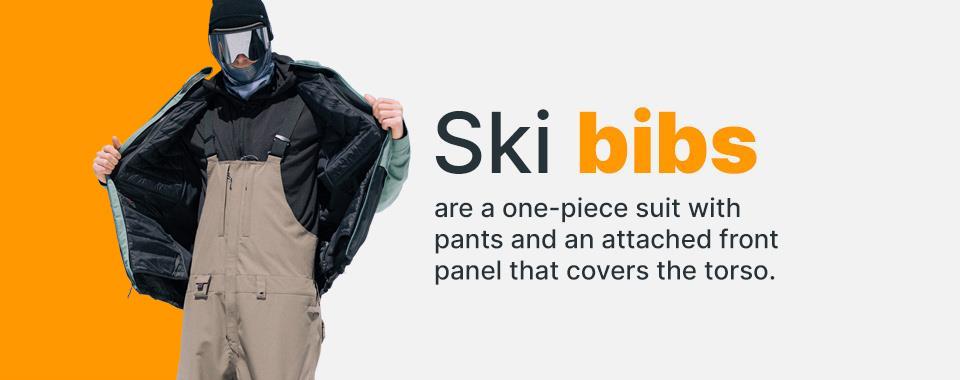
What Are Ski Pants?
A classic option for skiers and snowboarders, ski pants are like normal pants but with extra features made with skiing in mind. They provide protection from snow and are durable enough to withstand harsh skiing conditions. Unlike ski bibs, ski pants cinch at the waist with zippers, buttons or belts, and they have no extra material covering the torso. They're worn with a ski jacket and layers of clothing to keep you warm while skiing.
Which Is Better: Ski Pants or Bibs?
It may not be what you want to hear, but neither ski bibs nor ski pants are the "best" for skiing and snowboarding. Both are excellent choices. It can help to examine their advantages and disadvantages to help you pick the one that's right for you.
Advantages of Ski Bibs
Ski bibs naturally offer advantages over ski pants because they have additional material and straps. When you wear ski bibs while skiing or snowboarding, you'll see the following benefits:
- Better snow protection: The best advantage that ski bibs offer over ski pants is their ability to keep snow out. Because they're a solid piece extending past your hips, snow is less likely to make its way into your clothes, especially when you fall or slide.
- Comfortable fit: Thanks to the straps, you don't need a belt or band to keep ski bibs in place. This alleviates the pressure around the hips and waist, making them a comfortable choice. They're also often looser than ski pants, so they fit over clothing layers well.
- Extra warmth: The extra material covering your torso adds another layer of warmth, and without a gap by your hips, there's less chance of cold wind sneaking in while you move.
- Increased mobility: People often enjoy the freedom of movement ski bibs provide. There is less restriction around the waist, and the straps prevent them from falling. You'll have great flexibility and comfort performing tricks and maneuvers in ski bibs.
- More pockets: Who doesn't love a good pocket? With the extra material on ski bibs, there's even more room for pockets and storage. Plus, a pocket on your chest is sometimes easier to reach than one on your legs.
Disadvantages of Ski Bibs
While ski bibs are a convenient clothing option for skiing and snowboarding, they also have disadvantages and may not suit every person. Consider the following disadvantages of ski bibs to inform your choice:
- Complicated removal: When it's time to go to the bathroom or take a break, ski bibs can complicate the process. You'll have to remove your outer layers first, unclip the straps and then put it all back on afterwards. If this will frustrate you, purchase a ski bib with zips and flaps that let you go to the bathroom without taking them off.
- Odd feeling: Some people find wearing ski bibs slightly strange, especially for the first few wears. This is because they feel like they may fall off, as nothing is holding them onto your hips. Of course, the straps keep them securely in place, but you may need to wear them for a while to get used to the feeling.
- Too hot: If you're the type of person who gets hot easily, the extra material on your upper body may make you uncomfortable, especially on warmer days. If you still want to wear a ski bib without overheating, you can forgo a ski jacket and choose a breathable material with less insulation.
- Expensive: Ski bibs can be pricier than ski pants because of the extra fabric and complicated design. You're also paying for those added advantages, so some people consider it money well spent.
BROWSE SKI BIBS
Advantages of Ski Pants
Ski pants are a common choice among skiers and snowboarders for various reasons. Some of these include:
- Affordability: While there are varying price ranges for ski pants and bibs, ski pants tend to run on the more affordable side. If your budget is a bit lower, ski pants are a great option that still provides adequate protection from snow and wind.
- Easy removal: Taking off ski pants is easier than removing ski bibs, meaning you can go to the bathroom and undress quicker with less hassle. Because of this, ski pants are also a better option for people with limited mobility.
- Comfort control: Ski pants only cover your legs, so you can choose different levels of warmth and insulation for the top and bottom half of your body. Some people prefer wearing cool, breathable pants and insulated ski jackets, while others prefer the opposite.
- Familiar fit: Wearing ski pants feels just like wearing normal pants, and you can even wear your ski pants when shoveling snow at home. If wearing ski bibs bothers you, ski pants are the best bet.
- Greater mobility: We previously mentioned that ski bibs provide extra mobility, but some people actually feel less restricted in ski pants. You can twist and turn a lot easier, and there is less fabric to bulk up your outfit.
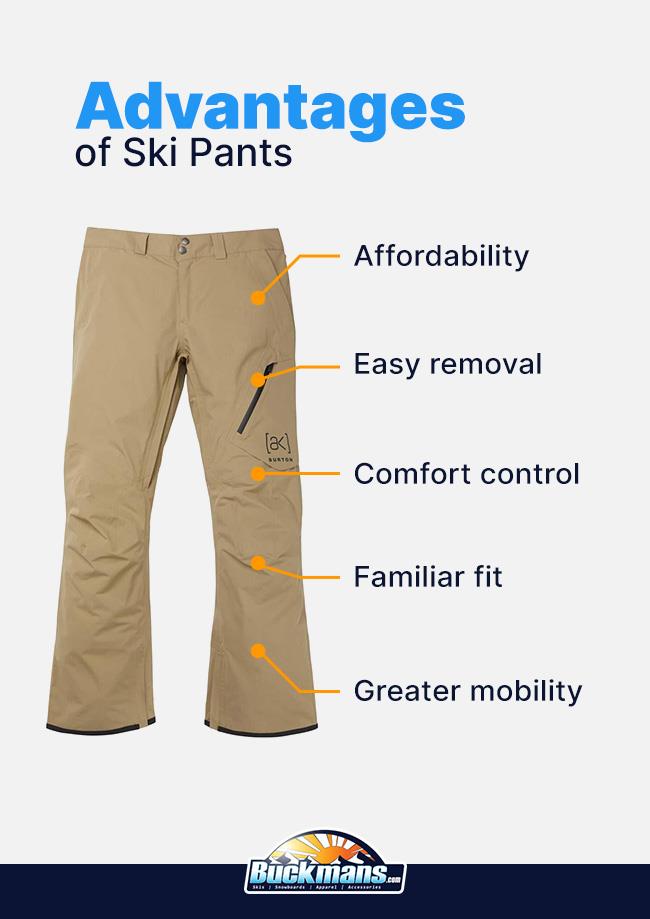
Disadvantages of Ski Pants
The drawbacks of ski pants are usually the reason people opt for ski bibs instead. Before you buy a pair of skin pants, consider the following disadvantages:
- Non-adjustable fit: Finding a pair of pants that fit your hips, thighs and waist can be difficult for some people, and there aren't many ways to adjust them post-purchase. Because of this, we suggest you try on pants first and ensure they fit right for maximum comfort. You can also buy suspenders and belts to help keep them up.
- Less snow protection: Ski pants with waterproof materials make a huge difference in the snow, but unfortunately, there's not much you can do to stop snow from entering the top of your pants and seeping into your clothing. This is even more of a problem for beginners, backcountry skiers and people who perform tricks.
- Less storage: It makes sense that ski pants don't have as many pockets as ski bibs, but it's something to think about if you carry a lot of stuff with you on the slopes. You can find ski pants with extra pockets or customize them if storage in ski pants is important to you.
- Discomfort: Ski pants can be slightly uncomfortable around your waist or hips, especially when you're wearing multiple layers or the band is too tight. Make sure to account for this when purchasing your ski pants.
BROWSE SKI PANTS
Making the Right Choice for Your Skiing Style
Choosing between ski pants and bibs is ultimately down to your personal preferences, but if you're struggling to choose, you can let weather conditions and your skiing style inform your choice.
If you go backcountry skiing outside of resorts or enjoy performing snowboarding stunts, a ski bib will help keep the snow out so you're dry for longer. If you're doing some light downhill skiing or snowboarding at a resort or over flat terrain, a pair of ski pants is sufficient to keep you comfortable.
Snow bibs are better for those really chilly, windy days when you need that extra warmth or for people who get cold easily. Ski pants are preferable on sunny snow days when it's not too cold or for people who get hot easily.
Once you've decided on either ski pants or bibs, you'll need to narrow down your options. There is a wide range of ski pants and ski bibs available, all with varying materials and designs to suit individual preferences. To make the choice easier, we suggest you consider waterproofing, insulation, fit and features while shopping.
Waterproofing
Make sure your ski clothing — including pants and bibs — is either water-resistant or waterproof. This is crucial for skiing and snowboarding comfort, as it prevents snow from making you wet and cold. There's a slight difference between the two.
Water-resistant material has a special finish — typically called DWR, which stands for durable water repellent — that repels water. This is sufficient to keep you dry and warm in light precipitation, but if you fall in the snow or the weather gets worse, this material may not keep you dry. Waterproof material completely prevents moisture penetration, even in the wettest conditions. For the best waterproof material on the market, look for products with Gore-Tex. This material is waterproof, windproof and breathable.
Waterproof ratings range from 5,000 to 20,000, with 20,000 being the most waterproof possible.
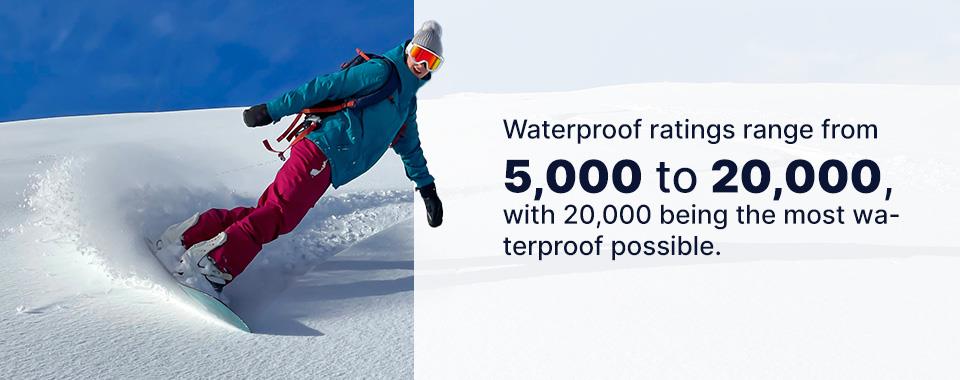
Insulation
Another important factor to consider when selecting your skin pants or bibs is how much insulation they have. The more insulated they are, the warmer you'll be. To see how much insulation ski clothing has, look for its insulation weight. Typically, insulation weights include none, lightweight, midweight and heavyweight, with heavyweight being the warmest.
You can also choose what type of insulation you want. Most ski clothing uses either synthetic or down insulation. Down insulation — made from duck or goose feathers — is more durable and warm compared to synthetic insulation. However, it's expensive and loses its insulation properties when it gets wet. Synthetic insulation is affordable, easy to care for, dries quickly and will still provide warmth when wet. Synthetic insulation may not last as long as down insulation. If you can't choose, a mix of both is the perfect option.
Fit and Sizing
Finding the correct fit and size for ski pants and bibs is essential for your comfort and mobility. You can choose from three different fits — fitted, regular and relaxed. Fitted pants hug your legs for an athletic look and less wind resistance. Regular and relaxed fits are looser than fitted pants, creating room for layering in cold weather. A relaxed fit offers the most room, and the baggy look is often a styling preference.
Features
With the waterproofing, insulation and fit sorted, you can move on to the fun part — features! Ski pants and bibs offer multiple features that add convenience and enjoyment to the skiing experience. Below are a few examples to choose from:
- Snow gaiters: Pants with snow gaiters include an elastic band that holds your bands close to your boots, preventing wind and snow from entering.
- Adjustability: Whether you select pants or bibs, be sure the waist bands or should straps are easily adjustable.
- Ventilation zips: When you get hot, ventilation zips — openings in the pants that close and open with a zip — will let the hot air escape from your pants. They're usually located near the inner thigh or near the hips.
- Ankle zips: Ankle zips are vertical zips at the bottom of trouser legs to create room for snow boots without bunching the material.
- Ticket holders: Some pants have an elastic or fabric hook where you can attach your ski ticket for easy access.
- Reinforcement: For extra durability for sit-down turns and knee drops, choose pants with reinforced knees and seat. Reinforced cuffs will also help hems last longer and reduce scuff marks.
Buy Ski Bibs and Pants From Buckman's Ski and Snowboard Shops
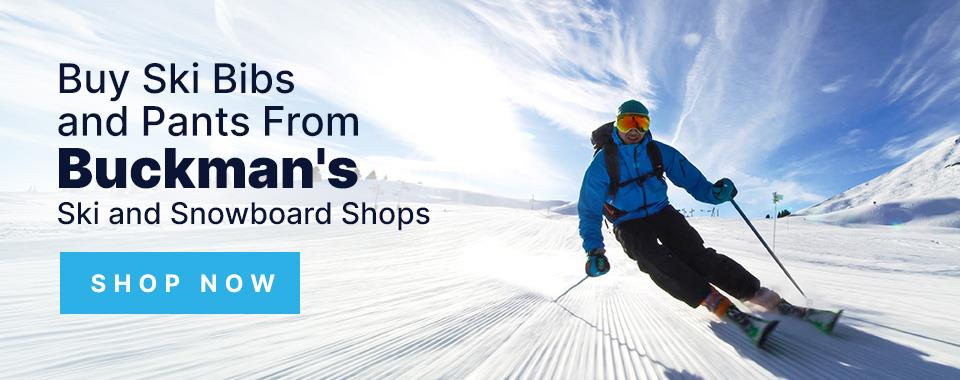
If you're looking for the best selection of ski pants and bibs, look no further than Buckman's Ski and Snowboard Shops. We're family-owned and operated, with stores throughout Eastern Pennsylvania. If you prefer to shop online, we have a convenient online store with free shipping on most orders over $50.
We stock a range of high-quality ski pants and bibs for women, men and children. Each product page lists important information regarding things like brand, price, color, fit, waterproofing, insulation and more to help you make an informed decision. We also have a handy feature that lets you compare up to three products side-by-side. Don't forget to check out our pre-trip checklist as well to ensure you have everything for your next ski or snowboard trip.
We're passionate about skiing and snowboarding and would love to help you find the right ski clothing for your needs. Visit one of our stores, call us at 1-866-550-1455 or fill out our online form for personalized assistance. We look forward to hearing from you!
Categories:
Ski equipment
|
Ski & Snowboarding Tips
|
Ski & Snowboard Apparel
Tagged: ski, snowboard, ski and snowboard equipment